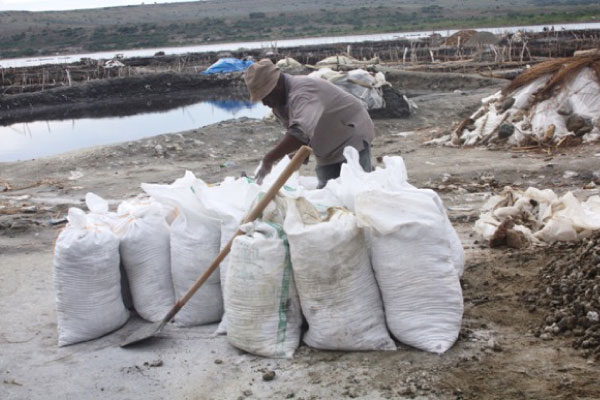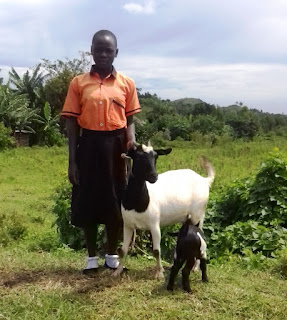A man packs salt in sacks at Lake Katwe in Kasese
District recently. Following a tree planting campaign launched in 2012, at the
shores of Lake Katwe, salt miners are now able to collect salt in large
volumes. PHOTOS BY FELIX BASIIME
THURSDAY JUNE 22 2017
By FELIX BASIIME
KASESE- Ms Sanyu
Madina, 27, is a salt miner at Lake Katwe in Kasese District. She has conducted
this business for the last eight years and operates seven salt pans.
Salt pans are man-made features on the lake shores where salt forms naturally and according to Ms Madina, Lake Katwe has more than 1000 salt pans.
When Daily Monitor visited her at one of the salt pans, Ms Madina revealed that for the eight years, she has never experienced such huge volumes of salt being harvested currently.
Salt pans are man-made features on the lake shores where salt forms naturally and according to Ms Madina, Lake Katwe has more than 1000 salt pans.
When Daily Monitor visited her at one of the salt pans, Ms Madina revealed that for the eight years, she has never experienced such huge volumes of salt being harvested currently.
“Since I was
born, I have never seen such volume of salt produced here because there is no
more flooding at the lake,” she says, adding, “Floods would submerge our salt
pans and block us from mining the salt”.
The slopes over the years were laid open by salt miners who cut the trees to create the salt pans on the lake shores, leading to soil erosion that caused siltation and flooding of the lake hence low production of the salt in the lake for the last seven years.
She attributes
the new changes to the restoration of the slopes around the lake after salt
miners embarked on tree planting campaign since 2012, an initiative of National
Association of Professional Environmentalists (NAPE), an environmental advocacy
body.
Lake Katwe is a crater lake situated inside Queen Elizabeth National Park.
Lake Katwe is a crater lake situated inside Queen Elizabeth National Park.
Mr Arinaitwe
Kagongo, the NAPE guide at the lake, says business was slow since May 2010,
after the lake flooded as a result of climate change threatening lives of more
than 8,000 residents who depend on salt extraction for a living.
“The flooding left more than 3,000 porters jobless and the urban authority lost Shs24m in revenue each year. Floods also forced residents to seek alternative jobs while a few resorted to extracting the muddy salty commonly known as Kifuufu, a poor quality that is at times sold to cattle keepers,” Mr Kagongo says.
Since then, the number of people working and owning small wells (salt plots) on the shallow lake kept dwindling due to slow business. Since May 2010, one could hardly find more than 20 people on the lake working.
A salt miner at
peak season would earn between Shs20,000 to Shs 40,000 daily before the
flooding of the lake. Mr Kagongo says the floods that hit the area between
2010, and 2011, dissolved the salt in more than 8,000 salt pans.
He attributed this to the environmental factors that Lake Katwe faced where the vegetation cover on the banks were degraded.
He attributed this to the environmental factors that Lake Katwe faced where the vegetation cover on the banks were degraded.
“Long ago, this
crater salty lake was surrounded by a forest, but it is gone, so rain water
just floods in the lake and therefore, salt rocks can’t form under such
conditions, but we have rejuvenated it and now production has resumed in high
gear,” he says.
According to Ms Madina, currently a sack of about 100kgs of rock salt goes for Shs15, 000 compared to the previous years when the lake would flood and there was nothing to extract.
“During the
period of floods at the lake, a sack of 100kgs would sell between Shs 20,000
and Shs 30,000 because there was low production” she recalls.
In January
2012, salt extraction resumed at the salty Lake Katwe in Katwe-Kabatooro Town
Council in Kasese District after a dormant one and half years due to flooding.
“The trees we planted have helped to reduce the erosion and flooding,” Ms Madina says.
“The trees we planted have helped to reduce the erosion and flooding,” Ms Madina says.
Business
usually booms during the dry seasons, (from January to March and
June-September) when the water in the shallow lake evaporates, exposing the
salty rocks underneath.
The salty lakes in Kasese District used to be Katwe, Nyamunuka, Bunyampaka and Munyanyange but today, only Katwe and Bunyampaka have salt.
Traders around East and Central Africa have for many years flocked Lake Katwe to load about eight to 10 lorries of salt daily.
The lake produces three types of salt; Crude salt for animal leak, edible salt (sodium chloride) and unwashed salt.
Revenue
According to the Town Clerk of Katwe-Kabatooro, Mr Godwin Bihanikire, in the last financial year, the urban authority received Shs438m in revenue as loading fees at the lake but in the new budget, they have projected Shs458m.
Mr Kagongo says Lake Katwe would have become barren like other salt lakes in the district if there were no interventions by NAPE and the salt miners to rejuvenate it.
According to the Town Clerk of Katwe-Kabatooro, Mr Godwin Bihanikire, in the last financial year, the urban authority received Shs438m in revenue as loading fees at the lake but in the new budget, they have projected Shs458m.
Mr Kagongo says Lake Katwe would have become barren like other salt lakes in the district if there were no interventions by NAPE and the salt miners to rejuvenate it.
“The problem is
that we used to cut the grass and trees from the slopes around the lake and on
the lake banks to create our salt wells, which caused the rain water runoff,
but this stopped and we started using sand in sacks,” says Ms Halima Nasanga, a
worker at the lake.
Mr Jeconious Musingwiire, the western region public awareness officer for NEMA, says: “There is need to properly manage the water catchment areas around Lake Katwe.”
Lake Katwe
remains the main source of income among the inhabitants of Katwe-Kabatoro Town
Council in Busongora South. People still practice rudimentary mining of salt to
earn a living.
As a solution to the current high production, Kagongo said they are trying to boost local market.
As a solution to the current high production, Kagongo said they are trying to boost local market.
“As miners, we
are trying to boost the local market of the salt through sensitising the public
that Katwe salt is safe for both human and animal consumption,” he adds.



